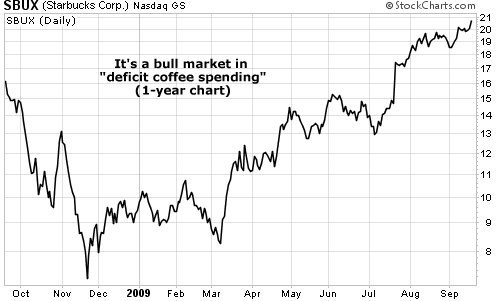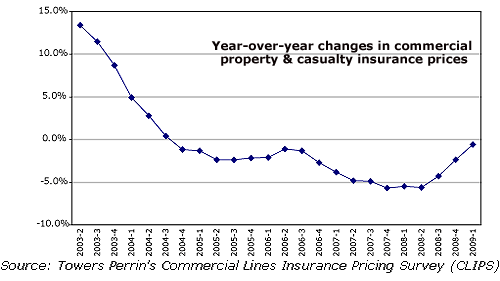| Home | About Us | Resources | Archive | Free Reports | Market Window |
How to Profit from Three Desperate CompaniesBy
Tuesday, September 22, 2009
I heard an interesting story last week from the CFO of an insurance company I follow...
This company had insured a restaurant in Miami last year. It's a modest restaurant with a property value of $1.5 million. It's located six miles from the coast, which makes it "zone one" in terms of hurricane risk. The insurance company had written a $1.5 million property insurance contract on this restaurant and a "companion" contract for a further $1 million to cover additional liabilities. It collected $46,000 in premium for writing this insurance. When it came to renewing the contract this year, the underwriters reviewed the case and decided the property was worth more than $1.5 million. They ran the new data through their risk models and decided to raise the price of their insurance to $54,000. The increase prompted the restaurant to shop around for a better deal. It found three other insurance companies willing to write the insurance for less than $40,000. The CFO used this story to explain to shareholders why his company is losing business every quarter. "The appetite from a lot of the competitors is much stronger than [ours] right now." The key to banking is, you never lend money at an interest rate that's too low, even if it means you lose business to a more aggressive lender. It's the same in insurance. Never write insurance when it's not profitable, even if it means you lose the business. There's a saying in the insurance industry that makes the point: "Volume is for vanity, but profit is for sanity." MarketScout tracks pricing trends in the insurance industry. In June, Richard Kerr, MarketScout's CEO, announced three publicly traded insurers were "clamoring for premium, seemingly at any rate." He called these insurers "the terrible trio," and said they were responsible for keeping insurance prices low across the whole industry. (Kerr didn't identify the terrible trio, but AIG is one of them. With the company on government life support, AIG's underwriters went on a massive insurance binge, collecting as many premiums as they could, as quickly as possible.) Here's the thing: These acts of desperation by a few large players almost always mark the bottom of the insurance price cycle. Towers Perrin's Commercial Lines Insurance Pricing Survey (CLIPS) is the most accurate pricing survey in the insurance business. CLIPS shows prices in property and casualty insurance have fallen every quarter for the last four years... and are now down as much as 66% from their peak after September 11, 2001. The chart shows the year-over-year change in insurance prices, as measured by CLIPS. When the line is above 0%, insurance prices are rising. When the line is below 0%, insurance prices are falling. Prices were still falling in the first quarter of 2009...
But the most recent survey shows prices fell less than 1% from the same time last year. "The smallest decline in four years provides increasing evidence that the soft market is reaching its end," says Insurance Services Network. The classic insurance cycle takes a decade to go full circle. Once the cycle turns, we should get three to five years of strong prices. As an investment analyst, I've studied all kinds of income products that can compound your wealth – including bonds, real estate investment trusts (REITs), blue-chip dividend growers, and high-yield stocks. But I've never found a mature business that compounds wealth better than a high-quality insurance company. One company I follow has compounded its stock price at 23% per year over the last 23 years. This includes the last weak insurance cycle, where shareholders made nothing for seven straight years. Another company has generated 16% compound annual growth in stock price over the past 25 years, but the CEO expects his company to "comfortably" exceed these returns going forward. Of course, the classic example of an insurance company that'll make excess returns in an insurance bull market is Berkshire Hathaway. It's the best insurance company in the world... and Warren Buffett, Berkshire's CEO, expects shareholders to compound their money by about 7% a year. With the insurance cycle about to turn, it's the perfect time to load up on top-quality insurance companies... Berkshire Hathaway is a great place to start your research. Good investing, Tom P.S. In the latest issue of my 12% Letter, I showed readers how to invest in the coming insurance bull market for both capital gains and income. We're in a position to generate returns in excess of 25% per year – and possibly a lot more – for three or four years in succession. To learn more about The 12% Letter, click here. Market NotesAN INCREDIBLE CHART FOR THE AMERICAN CONSUMER
America is back to the business of frivolous spending. That's the point of today's chart.
Longtime DailyWealth readers know we track shares of coffee chain Starbucks (SBUX) for a read on frivolous spending in America. You don't need to spend $4 on a fancy coffee when you can make it at home for 10 cents. As today's chart shows, America is spending money on expensive coffee again... SBUX just punched through to a new 52-week high, gaining 48% in the last three months. SBUX isn't an isolated case. The charts of many other high profile "spending stocks" look the same. Shares of Nordstrom (expensive retail), Tiffany (expensive jewelry), and Coach (expensive handbags) are soaring right now. These charts remind us of the claim that in the event of an apocalyptic nuclear war, two hardy species would survive to inherit the Earth: cockroaches and the American consumer. For better or worse, he is spending money again. 
|
In The Daily Crux
Recent Articles
|


